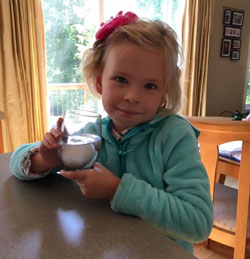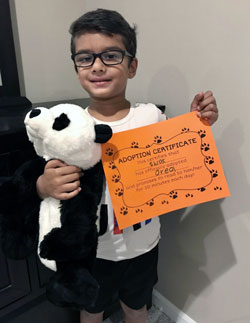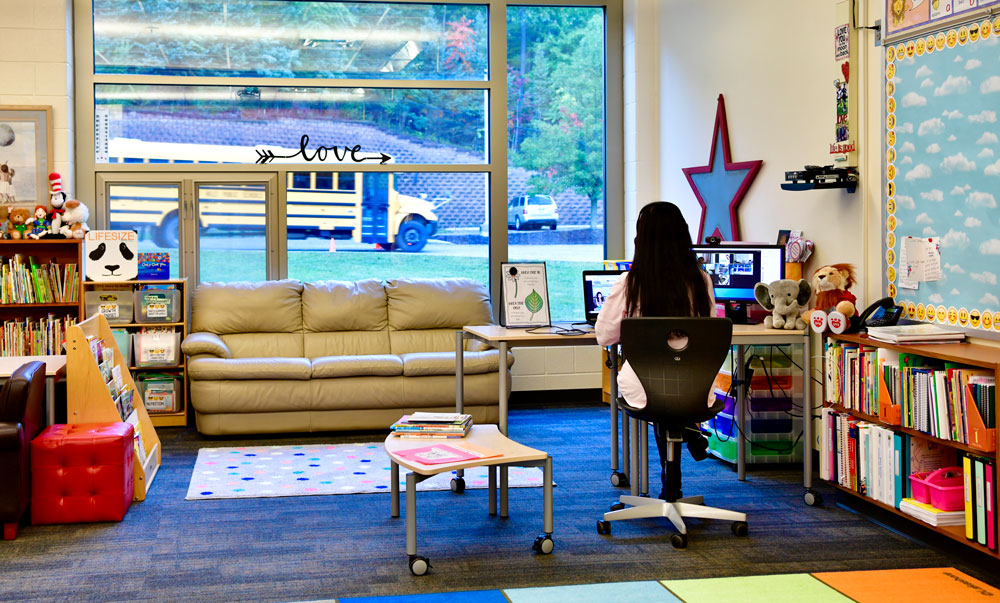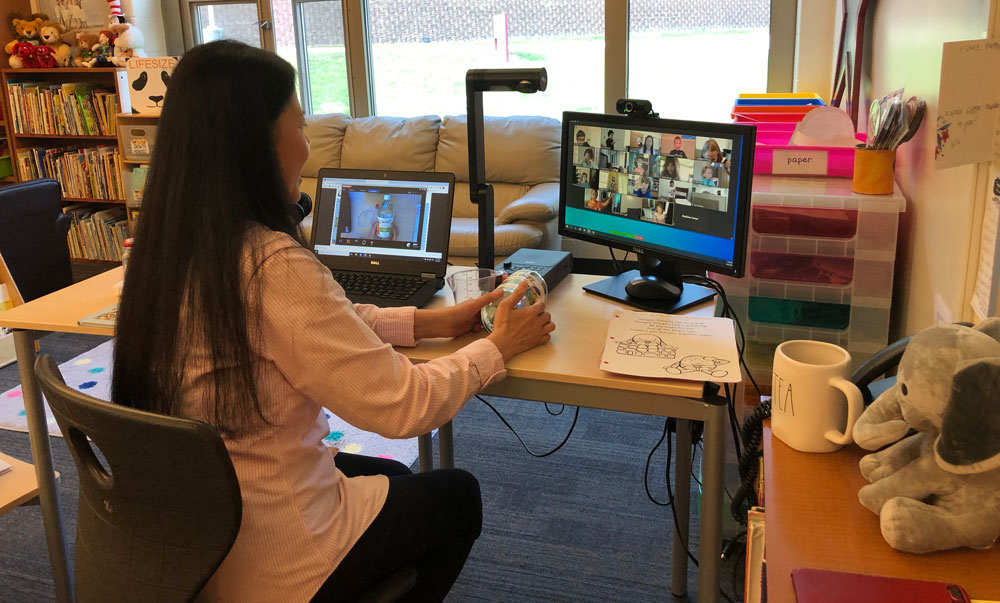On a recent Monday in Lana Tran’s first-grade classroom at Knapp Forest Elementary, the day’s activities were detailed via 24 colorful, link-laden slides that included phonics and math practice, a 45-minute lunch timer and a read-aloud.
Next up: in keeping with the nursery rhyme of the week, a science egg-speriment to see what would happen to Humpty Dumpty when he takes a three-day bath in vinegar.

Tran laid out her materials as her students sat rapt. Shlok Kawli set aside the rubber snake he had been dangling. Henry Moquin, in an unmuted moment, called to someone in his house for a measuring cup. Sophia Kremer’s smile was so wide it revealed a missing front tooth.
“Now, my friends, I am going to ask you to be scientists with me,” Tran said.
She quizzed them: “Who is Humpty Dumpty?”
Sophia raised her hand and waited to be unmuted: “He’s like a person but he’s an egg.”
Asked Tran: “Does anyone know what vinegar is?”
To which Vivian Weaver replied, “It makes other food a little bit sweeter and a little bit tastier. But it tastes yucky by itself.”

Learning and Patience
Tran is immunocompromised. The 26-year district teacher is in her regular classroom this year, but behind a locked door at her request. Her 18 students are at home, their parents having chosen distance learning.
Tran gets to the building early to prepare for the day. Her classroom window faces the drive where buses line up, and she often trades waves or gets brief visits through the glass from former students as they arrive.
She enjoys watching fellow teachers conduct lessons outdoors. “I know they’re overwhelmed too.”
It’s one kind of “always on” to teach a classroom of first-graders in person, another kind to do so virtually.
“I’m here all day, then on the computer at home after dinner to make my lessons,” Tran said. “Sometimes I’m up until 2 a.m. I wanted to make it easy for them.
“They’re so little, and they missed many months in school as kindergartners,” she said. “What you try to deliver at home is different. When I send them off to do their work (in virtual study rooms) I’m trying to share a screen and re-teach. They need that all the time.
“They have to learn to be very patient.”
When learning happens in person, Tran explained, students often work in pairs. In her class this year, their partner is often a grownup at home or a stuffed animal, though she’s becoming more adept at quickly separating pairs of first-graders into virtual breakout rooms.
‘I want to deliver what I do in the classroom through Zoom, but nothing compares to face to face.’
— Lana Tran, first-grade teacher
Tran said she misses being able to move quickly around the classroom to catch conversations in progress. “There’s a lot of wait time (in virtual learning). I want to deliver what I do in the classroom through Zoom, but nothing compares to face to face.”
Still, as she pops in and out of the virtual breakout rooms, “and I hear their conversations about writing, it just melts my heart.”

Grateful Goes Both Ways
Back to the egg experiment, Tran’s first-graders return from their virtual breakout rooms, where they noodled their best predictions for what will happen to Vinegar Humpty after three days.
The pint-sized scientists hypothesized:
“It will get cracked,” Shlok said.
“I think something will happen inside the egg,” was Sophia’s guess.
Offered Bella Bhuse: “I think it’s going to change color.”
The nursery rhyme-turned science experiment morphed into a writing exercise, where Tran assigned the first of what would be three observations.
“I feel very fortunate to be able to do this,” she said. “I love what I do because I can see their smiles, I can see they are engaging.”
Tran shared a handful of notes from appreciative parents. Jen Radtke, mother of first-grader Ethan Pither, sent praise nearly a month into the school year: “I just wanted to tell you that we think you are doing such an amazing job teaching virtually. I’m truly in awe every day with all you are doing, your creativity, your technology skills and your patience. Thank you, thank you, thank you!”
Tran returns parents’ awe. She understands not all students have the same resources, and that some of her first-graders are trying to focus while parents are working from home, siblings are also doing distance learning, and with the challenges of everyday distractions and technology hiccups.
“This just isn’t possible without parents’ support,” she said. “I want parents to know we are so grateful for them.”
CONNECT
Tran’s video explaining to her virtual students how to organize their class materials












